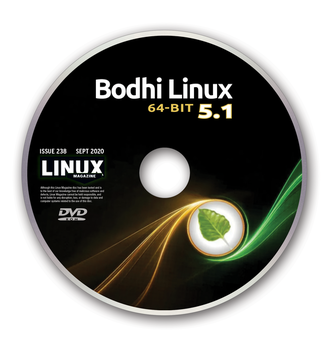On the DVD
On the DVD

openSUSE 15.2 and Bodhi Linux 5.1
OpenSUSE is one of the most popular Linux distributions. It is available in two versions: Leap, the stable version intended for average users and system administrators, and Tumbleweed, a rolling release for experimenters and those who want the very latest in hardware. Leap shares a common codebase with the commercial SUSE Linux Enterprise distribution, while Tumbleweed is developed in Factory, openSUSE's main development codebase, before release to help assure relative stability. All these projects are closely associated with each other.
In the past, the SUSE family of distributions was known for its contributions to KDE. Today, it is perhaps better known for its support of the Wayland graphics manager in the Gnome desktop environment. It also is known for a variety of unique tools, including the YaST Control Center, as well as AutoYaST, which provides automatic installations, and WebYaST, a browser interface. The SUSE family is also known for the ZYpp package manager and for the use of delta RPMs, which contain only the differences between old and new packages of the same name, a feature that speeds software installation. In addition, the SUSE family has developed its Build Services for packaging applications. It has experimented with automatic testing to improve software quality, as well as with the use of Flatpaks in one release variant. Although in many ways a mainstream distribution, openSUSE is at the forefront of innovation among distributions.
[...]
Buy this article as PDF
(incl. VAT)
Buy Linux Magazine
Subscribe to our Linux Newsletters
Find Linux and Open Source Jobs
Subscribe to our ADMIN Newsletters
Support Our Work
Linux Magazine content is made possible with support from readers like you. Please consider contributing when you’ve found an article to be beneficial.

News
-
Parrot OS Switches to KDE Plasma Desktop
Yet another distro is making the move to the KDE Plasma desktop.
-
TUXEDO Announces Gemini 17
TUXEDO Computers has released the fourth generation of its Gemini laptop with plenty of updates.
-
Two New Distros Adopt Enlightenment
MX Moksha and AV Linux 25 join ranks with Bodhi Linux and embrace the Enlightenment desktop.
-
Solus Linux 4.8 Removes Python 2
Solus Linux 4.8 has been released with the latest Linux kernel, updated desktops, and a key removal.
-
Zorin OS 18 Hits over a Million Downloads
If you doubt Linux isn't gaining popularity, you only have to look at Zorin OS's download numbers.
-
TUXEDO Computers Scraps Snapdragon X1E-Based Laptop
Due to issues with a Snapdragon CPU, TUXEDO Computers has cancelled its plans to release a laptop based on this elite hardware.
-
Debian Unleashes Debian Libre Live
Debian Libre Live keeps your machine free of proprietary software.
-
Valve Announces Pending Release of Steam Machine
Shout it to the heavens: Steam Machine, powered by Linux, is set to arrive in 2026.
-
Happy Birthday, ADMIN Magazine!
ADMIN is celebrating its 15th anniversary with issue #90.
-
Another Linux Malware Discovered
Russian hackers use Hyper-V to hide malware within Linux virtual machines.


